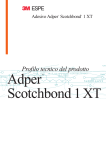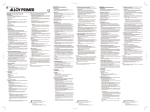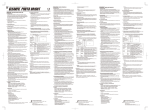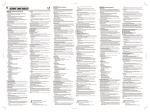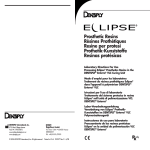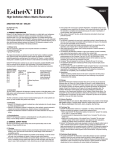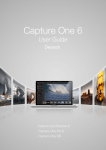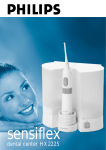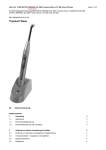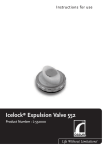Download instructions for use english mode d`emploi français modo de empleo
Transcript
007 C075-EUI FRANÇAIS MODE D'EMPLOI Ⅰ. INTRODUCTION CLEARFIL PHOTO BOND est un agent de collage à prise duale pour la dentine et l’émail conçu pour une utilisation avec des matériaux de restauration composite photopolymérisables. ENGLISH INSTRUCTIONS FOR USE I. INTRODUCTION CLEARFIL PHOTO BOND is a dual curing dentin and enamel bonding agent developed for use with composite light-curing restorative materials. II. INDICATIONS Enamel and dentin bonding agent for direct composite restorations III. CONTRAINDICATIONS Patients with a history of hypersensitivity to methacrylate monomers IV. POSSIBLE SIDE EFFECTS The oral mucosal membrane may turn whitish when contacted by BOND due to the coagulation of protein. This is usually a temporary phenomenon that will disappear in a few days. Instruct patients to avoid irritating the affected area while brushing. V. INCOMPATIBILITIES [1] Do not use eugenol-containing materials for pulp protection or temporary sealing since the eugenol can retard the curing process. [2] Do not use hemostatics containing ferric compounds since these materials may impair adhesion and may cause discoloration of the tooth margin or surrounding gingiva due to remaining ferric ions. [3] Do not use a hydrogen peroxide solution for cleaning cavities since it may weaken the bond strength to the tooth structure. VI. PRECAUTIONS 1. Safety precautions 1. This product contains substances that may cause allergic reactions. Avoid use of the product in patients with known allergies to methacrylate monomers or any other components. 2. If the patient demonstrates a hypersensitivity reaction, such as rash, eczema, features of inflammation, ulcer, swelling, itching or numbness, discontinue use of the product and seek medical attention. 3. Use caution to prevent the product from coming in contact with the skin or getting into the eye. Before using the product, cover the patient's eyes with a towel to protect them in the event of splashing material. 4. If the product comes in contact with human body tissues, take the following actions: <If the product gets in the eye> Immediately wash the eye with copious amounts of water and consult a physician. <If the product comes in contact with the skin or the oral mucosa> Immediately wipe the area with a cotton pellet or a gauze moistened with alcohol, and rinse with copious amounts of water. 5. Use caution to prevent the patient from accidentally swallowing the product. 6. Avoid using the same product dispensed into a well of the dispensing dish and the same disposable brush tip and the same sponge pledget for different patients to prevent cross-contamination infection. Discard the disposable brush tip and the sponge pledget after use. 7. Wear gloves or take other appropriate protective measures to prevent the occurrence of hypersensitivity that may result from contact with methacrylate monomers or any other components. 2. Handling and manipulation precautions 【Common precautions】 1. The product must not be used for any purposes other than specified in [II.INDICATIONS]. 2. The use of this product is restricted to licensed dental professionals. 3. Use a pulp capping agent in a cavity close to the pulp or in the event of accidental pulp exposure. 4. To prevent poor performance or poor handling characteristics, observe the specified light-curing times and other handling requirements. 5. Clean the cavity sufficiently to prevent poor bonding. If the adherend surface is contaminated with saliva or blood, wash it thoroughly and dry before bonding. 6. When using hemostatics containing aluminum chloride, minimize its quantity, and use caution to prevent contact with the adherend surface. Failure to do so might weaken the bond strength to the tooth structure. 7. Do not mix the product with any other dental materials. 8. Use a rubber dam to prevent contamination and to control moisture. 【BONDING AGENT】 1. Use the light blocking plate to avoid exposing the material to an operating light or natural light, and use within 2 minutes after dispensing. As the volatile ethanol which is contained in the BOND evaporates, the viscosity increases, thereby making it difficult to apply. 2. Universal Liquid contains a flammable substance. Do not use it near an open flame. 【K-ETCHANT GEL】 1. If the product adheres on clothes, wash off with water. 2. The product may be hardened when it is not in use. In that case, the content returns to liquid as shaking the bottle with the cap. VIII. CLINICAL PROCEDURES 1. Isolation and Moisture control Avoid contamination of the treatment area from saliva or blood to produce optimal results. A rubber dam is recommended to keep the tooth clean and dry. 2. Cavity preparations Remove any infected dentin and prepare the cavity in the usual manner. 3. Pulp protection Any actual or near pulp exposure could be covered with a hard setting calcium hydroxide material or other indicated materials. Do not use eugenol-containing materials for pulp protection. 4. Acid etching Dispense the necessary amount of K-ETCHANT GEL into a well of the mixing dish and apply it to the entire cavity surface with a disposable brush tip. Leave in place for 40 seconds, wash with water, and then dry. [NOTE] Care should be taken to prevent saliva from coming in contact with the etched tooth surface. Any contaminated tooth surface must be re-etched. 5. Application of BOND 5-1. Dispense equal amounts of Catalyst Liquid and Universal Liquid into a well of a mixing dish and mix immediately with a sponge pledget. [NOTE] Use the mixture of Catalyst Liquid and Universal Liquid as soon as possible after mixing. The mixture must be used within 2 minutes after mixing. 5-2. Apply mixed BOND to the entire cavity surface with the sponge pledget. [NOTE] Use caution not to allow saliva or exudates to contact the treated surfaces. 5-3. Dry the entire cavity surface sufficiently by blowing mild air until BOND does not move. Use a vacuum aspirator to prevent BOND from scattering. 5-4. When a composite resin restorative has a thickness of greater than 2 mm, BOND must be light-cured before the composite resin is placed into the cavity. Light-cure BOND for 10 seconds with a dental curing unit (see table “Dental curing unit”) [NOTE] If the thickness of composite resin is less than 2 mm, BOND does not need to be light-cured prior to placement of the composite resin. Table: Dental curing unit Type Light source Wavelength range and light intensity Halogen Light intensity2) of more than 300 mW/cm2 Halogen lamp in wavelength range from 400 - 515 nm LED Blue LED 1) Light intensity3) of more than 300 mW/cm2 in wavelength range from 400 - 515 nm 1) Peak of emission spectrum: 450 - 480 nm 2) Evaluated according to ISO 10650-1. 3) Evaluated according to ISO 10650-2. 6. Place composite resin restorative Apply composite resins (e.g. CLEARFIL MAJESTY Esthetic, CLEARFIL MAJESTY Posterior, CLEARFIL MAJESTY Flow) into the cavity, light-cure, finish and polish according to the manufacturer's instructions. [NOTE] If BOND has been light-cured, composite resins must be placed into the cavity within 1 minute after applying BOND. [WARRANTY] Kuraray Noritake Dental Inc. will replace any product that is proven to be defective. Kuraray Noritake Dental Inc. does not accept liability for any loss or damage, direct, consequential or special, arising out of the application or use of or the inability to use these products. Before using, the user shall determine the suitability of the products for the intended use and the user assumes all risk and liability whatsoever in connection therewith. [NOTE] "CLEARFIL" and "CLEARFIL MAJESTY" are trademarks of KURARAY CO., LTD. 【Dental light-curing unit】 1. Do not look directly at the light source. Protective glasses are recommended. 2. Low light intensity causes poor adhesion. Check the lamp for service life and the dental curing light guide tip for contamination. It is advisable to check the dental curing light intensity using an appropriate light evaluating device at appropriate intervals. 3. The emitting tip of the dental curing unit should be held as near and vertical to the resin surface as possible. If a large resin surface is to be light-cured, it is advisable to divide the area into several sections and light-cure each section separately. Ⅲ. CONTRE-INDICATIONS Patients connus pour leur hypersensibilité aux monomères de méthacrylate Ⅳ. EFFETS SECONDAIRES POSSIBLES La gencive peut devenir blanchâtre lorsqu’elle est mise en contact avec BOND, du fait d’une coagulation de la protéine. Ceci n’est qu’un phénomène temporaire qui disparaît généralement après quelques jours. Demander aux patients d’éviter toute irritation lors du brossage de la zone infectée. Ⅴ. INCOMPATIBILITÉS [1] Ne pas utiliser de matériaux contenant de l’eugénol pour la protection de la pulpe ou un scellement temporaire, étant donné que l’eugénol pourrait retarder le processus de polymérisation. [2] Ne pas utiliser d’hémostatiques contenant des composés ferriques, les ions ferriques résiduels de ces matériaux risquant de diminuer l’adhérence et de causer une décoloration au bord de la dent ou au niveau de la gencive environnante. [3] Ne pas utiliser de solution d’eau oxygénée (i.e. de peroxyde d’hydrogène) pour nettoyer les cavités, car cela risque de diminuer la force de liaison à la structure dentaire. Ⅵ. PRÉCAUTIONS 1. Consignes de sécurité 1. Ce produit contient des substances susceptibles de provoquer des réactions allergiques. L’utilisation de ce produit chez les patients présentant une allergie connue aux monomères méthacryliques ou à d'autres composants est vivement déconseillée. 2. Si le patient présente une réaction d’hypersensibilité sous forme d’érythème, d’eczéma, de signes caractéristiques d’inflammation, d’ulcère, de gonflement, de prurit ou d’engourdissement, cesser l’utilisation du produit et demander un avis médical. 3. Faire preuve de précaution pour empêcher le produit d’entrer en contact avec la peau ou les yeux. Avant l’utilisation, couvrir les yeux du patient avec une serviette pour les protéger des projections. 4. En cas de contact du produit avec les tissus du corps humain, prendre les mesures suivantes : <En cas de pénétration du produit dans les yeux> Rincer immédiatement les yeux abondamment à l’eau et consulter un médecin. <En cas de contact entre le produit et la peau ou les muqueuses buccales> Essuyez immédiatement avec un tampon ouaté ou de la gaze imprégné d’alcool, puis rincez abondamment à l’eau. 5. Prenez les mesures nécessaires pour éviter que le patient n’avale accidentellement le produit. 6. Évitez d’utiliser le même produit déjà versé dans le récipient de distribution, la même pointe de brosse à usage unique et le même tampon éponge pour différents patients afin d’éviter toute infection croisée. Jetez la pointe de brosse à usage unique et le tampon éponge après utilisation. 7. Portez des gants ou prenez les mesures de protection nécessaires pour éviter une hypersensibilité pouvant être causée par tout contact avec les monomères de méthacrylate ou à d'autres composants. 2. Précautions pour la manipulation 【Précautions générales】 1. Le produit ne doit pas être utilisé dans tout autre but que ceux spécifiés dans les [II.INDICATIONS]. 2. L’utilisation de ce produit est limitée à l’usage des chirurgiens dentistes agréés. 3. Utiliser un agent de coiffage pulpaire dans une cavité à proximité de la pulpe ou en cas d’exposition accidentelle de la pulpe. 4. Pour éviter de mauvais résultats et de mauvaises caractéristiques de manipulation, se référer aux durées de photopolymérisation et autres exigences de manipulation. 5. Nettoyer correctement la cavité pour s’assurer de la bonne tenue du scellement. Si la surface d’adhérence est contaminée par de la salive ou du sang, la laver soigneusement et la sécher avant le scellement. 6. Lors de l’utilisation d’hémostatiques contenant du chlorure d’aluminium, diminuer la quantité et utiliser prudemment pour éviter tout contact avec la surface adhérente. En cas de contact, la force de liaison sur la structure dentaire risque d’être diminuée. 7. Ne mélanger le produit à aucun autre matériau dentaire. 8. Utiliser une digue en caoutchouc pour éviter toute contamination et contrôler l’humidité. 【BONDING AGENT】 1. Utiliser la plaque protectrice contre la lumière pour éviter d’exposer le matériau à la lumière de la lampe d’opération ou à la lumière naturelle et utiliser dans les 2 minutes une fois versé. L’éthanol volatile contenu dans le BOND s’évapore ce qui accroît la viscosité du produit et rend son application difficile. 2. Universal Liquid contient une substance inflammable. Ne pas utiliser ce produit près d'une flamme nue. 【K-ETCHANT GEL】 1. Si du produit est projeté sur les vêtements, rincez à l’eau. 2. Le produit peut durcir lorsqu'il n'est pas utilisé. Dans ce cas, le contenu redevient liquide en agitant la bouteille avec le capuchon vissé. 【Unité dentaire de photopolymérisation】 1. Ne pas regarder directement vers la source lumineuse. Le port de lunettes de protection est recommandé. 2. Une faible intensité lumineuse provoquera une adhérence médiocre. Vérifier la lampe quant à sa durée de vie et l'embout de guidage de la lampe de polymérisation dentaire quant à une éventuelle contamination. Il est recommandé de vérifier l'intensité de la lampe de polymérisation dentaire en utilisant à intervalles périodiques un dispositif d'évaluation de l'intensité lumineuse. 3. L’embout émetteur de l’unité dentaire de polymérisation doit être tenu le plus près et le plus possible à la verticale par rapport à la surface de la résine. Si une surface importante de résine doit être photopolymérisée, il est recommandé de la diviser en différentes sections et de les photopolymériser chacune séparément. 3. Storage precautions 1. The product must be used by the expiration date indicated on the package. 2. This product and BONDING AGENT must be refrigerated (2-8°C / 36-46°F) when not in use. K-ETCHANT GEL must be stored at 2-25°C / 36-77°F when not in use. 3. The container of BONDING AGENT should be tightly capped immediately after use to reduce the evaporation of the volatile solvent (ethanol contained in Universal Liquid). 4. The product must be kept away from extreme heat, direct sunlight or a flame. 5. The product must be stored in a proper place where only dental practitioners can access. ESPAÑOL MODO DE EMPLEO Ⅰ. INTRODUCCIÓN CLEARFIL PHOTO BOND es un agente adhesivo de dentina y esmalte de polimerización dual desarrollado para ser utilizado con materiales restauradores compuestos fotopolimerizados. Ⅱ. INDICACIONES Agente adhesivo de esmalte y dentina para restauraciones compuestas directas Ⅷ. PROCÉDURES CLINIQUES 1. Isolation et contrôle de l’humidité Pour obtenir les meilleurs résultats possibles, éviter que la surface à traiter soit contaminée par de la salive ou de l’exsudat. Il est conseillé de poser une digue en caoutchouc pour maintenir la dent propre et sèche. 2. Préparations de la cavité Retirer toute la dentine infectée et préparer la cavité de la manière habituelle. 3. Protection de la pulpe Toute exposition directe ou indirecte de la pulpe pourrait être couverte au moyen d'un matériau en hydroxyde de calcium à prise dure. Ne pas utiliser de matériaux contenant de l’eugénol pour la protection de la pulpe. 4. Mordançage à l’acide Versez la quantité nécessaire de K-ETCHANT GEL dans le récipient de mélange et appliquez-le sur l’intégralité de la surface de la cavité à l'aide d’une pointe de brosse à usage unique. Laisser agir 40 secondes, rincer à l’eau claire et sécher. [REMARQUE] Prenez soin d'éviter que de la salive entre en contact avec la surface mordancée de la dent. Toute surface de dent contaminée doit être à nouveau mordancée. 5. Application de BOND 5-1. Versez la même quantité de Catalyst Liquid et d’Universal Liquid dans un récipient de mélange et mélangez immédiatement à l’aide d’un tampon éponge. [REMARQUE] Utilisez le mélange à base de Catalyst Liquid et d’Universal Liquid le plus rapidement possible après mélange. Le mélange doit être utilisé dans les 2 minutes suivant sa préparation. 5-2. Appliquez BOND mélangé sur l’intégralité de la surface de la cavité à l’aide du tampon éponge. [REMARQUE] Veiller à éviter tout contact entre la salive ou l’exsudat et les surfaces traitées. 5-3. Séchez l’intégralité de la surface de la cavité correctement à l’aide d’un jet d’air frais jusqu’à ce que BOND ne bouge plus. Utilisez un aspirateur pour éviter que BOND ne se répande. 5-4. Lorsque l’épaisseur du matériau de restauration composite résineux excède 2 mm, il faut photopolymériser BOND avant la pose de la résine composite dans la cavité. Photopolymériser le BOND pendant 10 secondes à l’aide d’un lampe de polymérisation dentaire (voir tableau « lampe de polymerization dentaire »). [REMARQUE] Si l’épaisseur de la résine composite n’excède pas 2 mm, il n’est pas nécessaire de photopolymériser BOND avant la pose de la résine composite. Tableau : Lampe de polymérisation dentaire Type Source lumineuse Plage de longueurs d’onde et intensité lumineuse Halogène Lampe halogène Intensité lumineuse2) supérieure à 300 mW/cm2 dans une plage de longueurs d’onde comprise entre 400 - 515 nm LED LED bleue1) Intensité lumineuse3) supérieure à 300 mW/cm2 dans une plage de longueurs d’onde comprise entre 400 - 515 nm 1) Pic du spectre d’émission : 450 - 480 nm 2) Évalué conformément à la norme ISO 10650-1. 3) Évalué conformément à la norme ISO 10650-2. 6. Application de la résine composite restauratrice Appliquer une résine composite (par exemple, CLEARFIL MAJESTY Esthetic, CLEARFIL MAJESTY Posterior, CLEARFIL MAJESTY Flow) dans la cavité, photopolymériser, procéder à la finition et au polissage conformément aux recommandations du fabricant. [REMARQUE] Si BOND a été photopolymérisé, la pose des résines composites dans la cavité doit intervenir dans 1 minute suivant l’application de BOND. [GARANTIE] Kuraray Noritake Dental Inc. s'engage à remplacer tout produit défectueux. Kuraray Noritake Dental Inc. décline toute responsabilité en cas de pertes ou dommages directs ou indirects, ou inhabituels, découlant de l’utilisation du produit ou d’une utilisation inappropriée. Avant utilisation, l’utilisateur s’engage à vérifier que les produits sont bien appropriés à l’usage qu’il compte en faire et l’utilisateur endosse tous risques et responsabilités associés. [REMARQUE] «CLEARFIL» et «CLEARFIL MAJESTY» sont des marques de KURARAY CO., LTD. Kuraray Europe GmbH Philipp-Reis-Str. 4, 65795 Hattersheim am Main, Germany Phone:+49 (0)69 305 35 840 Fax:+49 (0)69 305 35 640 2. Principaux ingrédients 1) BONDING AGENT (1) Catalyst Liquid • Bisphénol A diglycidylméthacrylate • Phosphate dihydrogène 10-méthacryloyloxydécyle • Méthacrylate de 2-hydroxyéthyle • Diméthacrylate aliphatique hydrophobe Ⅳ. POSIBLES EFECTOS SECUNDARIOS La encia puede ponerse blanca cuando entra en contacto con BOND debido a la coagulación de la proteína. Esto es un fenómeno temporal que desaparecerá generalmente en unos pocos días. Instruya a los pacientes para que eviten irritar el área afectada durante el cepillado. Ⅴ. INCOMPATIBILIDADES [1] No utilice materiales que contengan eugenol para proteger la pulpa o para la obturación provisional, porque el eugenol puede retrasar el proceso de polimerización. [2] No utilice agentes hemostáticos que contengan compuestos férricos, dado que estos materiales impedirán la adhesión y podrían provocar una decoloración en el margen de los dientes o alrededor de la encía, debido a los iones férricos que pueden quedar. [3] No utilice una solución de peróxido de hidrógeno para la limpieza de cavidades dado que podría debilitar la solidez de la unión a la estructura del diente. Ⅵ. PRECAUCIONES 1. Precauciones de seguridad 1. Este producto contiene sustancias que pueden originar reacciones alérgicas. Evite el uso del producto en pacientes con alergias conocidas a los monómeros de metacrilato o a cualesquiera otros componentes. 2. Si el paciente presenta alguna reacción de hipersensibilidad, tal como erupción, eccema, inflamación, úlcera, hinchazón, picor o entumecimiento, interrumpir el uso del producto y consultar a un médico. 3. Sea precavido impidiendo que el producto entre en contacto con la piel o penetre en los ojos. Antes de utilizar el producto, cubrir los ojos del paciente con una toalla para protegerlos en el caso de salpicadura del material. 4. Adoptar las siguientes medidas si el producto entra en contacto con los tejidos humanos: <Si el producto entra en los ojos> Enjuagar inmediatamente los ojos con abundante agua y consultar a un médico. <Si el producto entra en contacto con la piel o con la mucosa oral> Limpie con una compresa de algodón o gasa humedecida en alcohol y enjuague de inmediato con abundante agua. 5. Evite que el paciente ingiera accidentalmente el producto. 6. Evite usar el mismo producto dispensado en un hueco del plato dispensador, la misma punta de cepillo desechable y la misma esponja en distintos pacientes para evitar infecciones por contaminación cruzada. Deseche la punta de cepillo desechable y la esponja después del uso. 7. Póngase guantes o tome las medidas de protección adecuadas para evitar la aparición de hipersensibilidad que puede resultar del contacto con los monómeros de metacrilato o a cualquier otro componente. 2. Precauciones de uso y manipulación 【Precauciones comunes】 1. No debe utilizarse el producto para ningún fin distinto de los especificados en [II.INDICACIONES]. 2. El uso de este producto está limitado a los profesionales dentales autorizados. 3. Utilice un agente obturador de la pulpa en una cavidad cercana a la pulpa o en el caso de una exposición accidental de la pulpa. 4. Para evitar una manipulación y rendimiento deficientes, tenga en cuenta los tiempos de fotopolimerización especificados y otros requisitos de manipulación. 5. Limpie la cavidad lo suficiente como para prevenir una mala unión. Si la superficie adherente está contaminada con saliva o sangre, lávela a fondo y séquela antes de proceder a la unión. 6. Cuando se empleen agentes hemostáticos que contengan cloruro de aluminio, minimizar su cantidad, y tomar precauciones para impedir la entrada en contacto con la superficie adherente. Caso de no hacerse así, se podría debilitar la solidez de la unión a la estructura del diente. 7. No mezcle el producto con ningún otro material dental. 8. Utilice una barrera de goma para impedir la contaminación y para el control de la humedad. 【BONDING AGENT】 1. Utilice la placa opaca para evitar la exposición del material a la luz de trabajo o natural y utilícela dentro de los 2 minutos tras la dosificación. Debido a que el etanol volátil contenido en el BOND se evapora, la viscosidad se incrementa, lo que dificulta su aplicación. 2. Universal Liquid contiene una sustancia inflamable. No lo utilice cerca de una llama abierta. 【K-ETCHANT GEL】 1. Si el producto se adhiere a la ropa, lávelo con agua. 2. El producto puede endurecerse cuando no se utiliza. En tal caso, el contenido volverá a ser líquido al agitar la botella con el tapón colocado. 【Unidad de curado con luz de uso dental】 1. No mirar directamente al foco luminoso. Se recomienda usar gafas de protección. 2. Una baja intensidad de luz provoca una mala adhesión. Comprobar la vida útil de la lámpara y l a presencia de contaminación en la punta guía de la luz de curado dental. Se recomienda controlar la intensidad de luz de la lámpara de polimerización con la periodicidad apropiada sirviéndose de un comprobador de luz adecuado. 3. La punta de emisión de la lámpara de polimerización debe mantenerse lo más próxima y vertical posible con respecto a la superficie de la resina. Si se va a curar con luz una superficie de resina grande, se recomienda divider la zona en varias secciones y curar con luz cada sección por separado. Ⅷ. PROCEDIMIENTOS CLÍNICOS 1. Aislamiento y control de la humedad Para obtener unos resultados óptimos evite la contaminación con saliva o sangre del área sometida a tratamiento. Se recomienda usar un dique de goma para mantener el diente limpio y seco. 2. Preparación de las cavidades Retire la dentina infectada y prepare la cavidad de la forma habitual. 3. Protección de la pulpa Cualquier punto de la pulpa, o cercano a ella, que quede expuesto podría cubrirse con un material de fraguado duro como el hidróxido cálcico u otro material indicado. No utilice materiales que contengan eugenol para proteger la pulpa. 4. Grabado al ácido Dispense la cantidad necesaria de K-ETCHANT GEL en un recipiente de mezcla y aplíquelo a la totalidad de la superficie de la cavidad con una punta de cepillo desechable. Déjelo reposar durante 40 segundos, lávelo con agua y séquelo. [NOTA] Se debe tener cuidado para evitar que la saliva entre en contacto con la superficie del diente grabado. Cualquier superficie de diente contaminada deberá ser grabada de nuevo. 5. Aplicación de BOND 5-1. Dispense cantidades iguales de Catalyst Liquid y Universal Liquid en un hueco del plato de mezclado y mezcle inmediatamente con una esponja. [NOTA] Utilice la mezcla de Catalyst Liquid y Universal Liquid tan pronto como sea posible después del mezclado. La mezcla debe utilizarse en los 2 minutos siguientes al mezclado. 5-2. Aplique BOND mezclado a la totalidad de la superficie de la cavidad con la esponja. [NOTA] Tenga cuidado de que la saliva o los exudados del tejido no entren en contacto con las superficies tratadas. 5-3. Seque suficientemente toda la superficie de la cavidad soplando suavemente aire hasta que BOND no se mueva. Use un aspirador para evitar salpicaduras del BOND. 5-4. Cuando una resina compuesta restauradora tenga un espesor de más de 2 mm, BOND debe fotopolimerizarse antes de colocar la resina compuesta en la cavidad. Fotopolimerice el BOND durante 10 segundos con una unidad de polimerización de uso dental (véase la tabla “Unidad de polimerización de uso dental”). [NOTA] Si el espesor de la resina compuesta es menor de 2 mm, no es necesario un fotopolimerizado de BOND antes de la colocación de la resina compuesta. Tabla: Unidad de polimerización de uso dental Tipo Fuente de luz Rango de longitud de onda e intensidad de la luz Halógena Lámpara halógena Intensidad de la luz2) de más de 300 mW/cm2 en un rango de longitud de onda de 400 - 515 nm LED LED azul1) Intensidad de la luz3) de más de 300 mW/cm2 en un rango de longitud de onda de 400 - 515 nm 1) Pico del espectro de emisión: 450 - 480 nm 2) Evaluado conforme a la norma ISO 10650-1. 3) Evaluado conforme a la norma ISO 10650-2. 6. Colocación del restaurador de resina compuesta Aplique la resina compuesta (por ejemplo, CLEARFIL MAJESTY Esthetic, CLEARFIL MAJESTY Posterior, CLEARFIL MAJESTY Flow) en la cavidad, fotopolimerice, acabe y pula según las instrucciones del fabricante. [NOTA] Si se ha producido un fotopolimerizado de BOND, las resinas compuestas deben colocarse en la cavidad en 1 minuto siguiente de la aplicación de BOND. [GARANTÍA] Kuraray Noritake Dental Inc. sustituirá cualquier producto que resulte defectuoso. Kuraray Noritake Dental Inc. no acepta responsabilidad alguna por pérdida o daño, directo, indirecto, resultante o especial, derivado de la aplicación o el uso o la incapacidad para utilizar estos productos. Antes de la utilización, el usuario determinará la idoneidad de los productos para el uso previsto y el usuario asume todo riesgo y responsabilidad en relación con esto. [NOTA] "CLEARFIL" y "CLEARFIL MAJESTY" son marcas de KURARAY CO., LTD. Ⅶ. COMPONENTES 1. Componentes Por favor, vea el exterior del envase para conocer el contenido y la cantidad. 1) BONDING AGENT (1) Catalyst Liquid (2) Universal Liquid 2) K-ETCHANT GEL 3) Accesorios • Mixing dish (Disco de mezcla) • Brush tip handle (white) [Pinceles desechables (blancas)] • Disposable brush tips (white) [Puntas de cepillo desechables (blancas)] • Sponge pledget (Esponja) Ⅶ. COMPOSANTS 1. Composants Contenu et quantités : voir sur l'emballage. 1) BONDING AGENT (1) Catalyst Liquid (2) Universal Liquid 2) K-ETCHANT GEL 3) Accessoires • Mixing dish (Godet mélangeur) • Brush tip handle (white) [Poignée pour embouts de pinceaux (blanches)] • Disposable brush tips (white) [Pointes de brosse à usage unique (blanches)] • Sponge pledget (Tampon éponge) 1621 Sakazu, Kurashiki, Okayama 710-0801, Japan Ⅲ. CONTRAINDICACIONES Pacientes con un historial de hipersensibilidad a los monómeros de metacrilato (2) Universal Liquid • Etanol • Catalizadores • Aceleradores 2) K-ETCHANT GEL • Ácido fosfórico • Agua • Silicio coloidal • Colores 3. Precauciones de almacenamiento 1. El producto deberá ser utilizado antes de la fecha de caducidad indicada en el envase. 2. Este producto y el BONDING AGENT deben refrigerarse (2-8°C / 36-46°F) cuando no se utilicen. K-ETCHANT GEL debe ser almacenado a 2-25°C / 36-77°F cuando no se utilice. 3. El envase de BONDING AGENT debe taparse bien inmediatamente después del uso para reducir la evaporación del disolvente volátil (etanol contenido en Universal Liquid). 4. El producto debe mantenerse alejado del calor extremo, de la luz directa del sol o llamas. 5. El producto debe ser almacenado en lugares adecuados a los que sólo tengan acceso los profesionales dentales. 3. Consignes de conservation 1. Le produit doit être utilisé avant la date de péremption indiquée sur l’emballage. 2. Ce produit ainsi que BONDING AGENT doivent être réfrigérés (2-8°C / 36-46°F) lorsqu’ils ne sont pas utilisés. K-ETCHANT GEL doit être conservé à 2-25°C / 36-77°F lorsqu'il n'est pas utilisé. 3. Le récipient de BONDING AGENT doit être correctement refermé après utilisation pour minimiser l’évaporation du solvant volatile (Universal Liquid contient de l’éthanol). 4. Le produit ne doit pas être exposé à une chaleur extrême, directement à la lumière solaire ou une flamme nue. 5. Le produit doit être conservé dans un endroit adéquat, auquel seuls des dentistes ont accès. VII. COMPONENTS 1. Components Please see the outside of the package for contents and quantity. 1) BONDING AGENT (1) Catalyst Liquid (2) Universal Liquid 2) K-ETCHANT GEL 3) Accessories • Mixing dish • Brush tip handle (white) • Disposable brush tips (white) • Sponge pledget 2. Principal ingredients 1) BONDING AGENT (1) Catalyst Liquid • Bisphenol A diglycidylmethacrylate (Bis-GMA) • 10-Methacryloyloxydecyl dihydrogen phosphate (MDP) • 2-Hydroxyethyl methacrylate (HEMA) • Hydrophobic aliphatic dimethacrylate • Benzoyl peroxide • dl-Camphorquinone (2) Universal Liquid • Ethanol • Catalysts • Accelerators 2) K-ETCHANT GEL • Phosphoric acid • Water • Colloidal silica • Dyes Ⅱ. INDICATIONS Agent de collage pour l’émail et la dentine permettant des restaurations composites directes. • Peroxide de benzoyle • dl-Camphoroquinone (2) Universal Liquid • Ethanol • Catalyseurs • Accélérateurs 2) K-ETCHANT GEL • Acide phosphorique • Eau • Silice colloïdal • Colorants 1621 Sakazu, Kurashiki, Okayama 710-0801, Japan Kuraray Europe GmbH Philipp-Reis-Str. 4, 65795 Hattersheim am Main, Germany Phone:+49 (0)69 305 35 840 Fax:+49 (0)69 305 35 640 2. Ingredientes principales 1) BONDING AGENT (1) Catalyst Liquid • Diglicidilmetacrilato A bisfenol • Fosfato biácido metacriloiloxidecilo 10 • Metacrilato de 2-hidroxietilo • Dimetacrilato alifático hidrofóbico • Peróxido de benzoílo • Alcanforquinona dl 1621 Sakazu, Kurashiki, Okayama 710-0801, Japan Kuraray Europe GmbH Philipp-Reis-Str. 4, 65795 Hattersheim am Main, Germany Phone:+49 (0)69 305 35 840 Fax:+49 (0)69 305 35 640 ITALIANO INSTRUZIONI PER L'USO Ⅰ. INTRODUZIONE CLEARFIL PHOTO BOND è un agente legante per dentina e smalto a polimerizzazione duale, studiato per l’uso con materiali restaurativi compositi fotopolimerizzabili. Ⅱ. INDICAZIONI Agente legante per smalto e dentina per restauri compositi diretti Ⅲ. CONTROINDICAZIONI Pazienti con una storia di ipersensibilità verso i monomeri metacrilati Ⅳ. POSSIBILI EFFETTI COLLATERALI La mucosa orale può divenire biancastra qualora venga a contatto con BOND, a causa della coagulazione della proteina. Si tratta di un fenomeno temporaneo che solitamente sparisce in pochi giorni. Istruire i pazienti affinché evitino di irritare l’area interessata quando spazzolano i denti. Ⅴ. INCOMPATIBILITÀ [1] Non usare materiali a base di eugenolo per la protezione della polpa o la sigillatura temporanea in quanto l'eugenolo potrebbe ritardare il processo di polimerizzazione. [2] Non usare emostatici contenenti composti ferrosi, poiché questi materiali possono compromettere l’adesione e causare una discromia del margine dentale o della gengiva circostante, a causa degli ioni ferrosi residui. [3] Non usare una soluzione di perossido di idrogeno per pulire le cavità, poiché potrebbe indebolire la forza di adesione alla struttura dentale. Ⅵ. PRECAUZIONI 1. Precauzioni di sicurezza 1. Questo prodotto contiene sostanze che possono causare reazioni allergiche. Evitare l’uso del prodotto su pazienti con allergie conclamate ai monomeri di metacrilato o a qualsiasi altro componente. 2. Se il paziente presenta una reazione di ipersensibilità come eruzione cutanea, eczema, infiammazione, ulcerazione, gonfiore, prurito o insensibilità interrompere l’uso del prodotto e consultare un medico. 3. Prestare attenzione affinché il prodotto non venga a contatto con la pelle o con gli occhi. Prima di utilizzare il prodotto, coprire gli occhi del paziente con un panno e proteggere gli occhi del paziente contro eventuali schizzi di materiale. 4. Se il prodotto viene a contatto con i tessuti del corpo umano, adottare le seguenti misure: <Se il prodotto entra negli occhi> Lavare immediatamente l’occhio con abbondante acqua e consultare un medico. <Se il prodotto entra in contatto con la pelle o le mucose orali> Rimuovere immediatamente il materiale utilizzando un tampone di cotone o garza inumiditi con alcol, quindi lavare con abbondante acqua. 5. Prestare la massima attenzione affinché il paziente non rischi di ingoiare accidentalmente il prodotto. 6. Evitare di usare lo stesso prodotto erogato in una vaschetta del piattino di erogazione, la stessa punta del pennello monouso e lo stesso tampone di spugna su pazienti diversi al fine di prevenire l’infezione da contaminazione incrociata. Gettare la punta del pennello monouso e il tampone di spugna dopo l’uso. 7. Indossare guanti o prendere appropriate misure protettive per evitare l’insorgere di ipersensibilità che potrebbe derivare dal contatto con i monomeri metacrilati o altri componenti. 2. Precauzioni d'uso e di manipolazione 【Avvertenze generali】 1. Il prodotto non deve essere utilizzato per scopi diversi da quelli elencati nelle [II.INDICAZIONI]. 2. L'utilizzo del prodotto è riservato esclusivamente a professionisti del settore. 3. Utilizzare un agente per l’incappucciamento in una cavità prossima alla polpa o in caso di esposizione accidentale della polpa. 4. Per evitare una bassa prestazione e una scarsa lavorabilità, rispettare i tempi indicati per la fotopolimerizzazione e gli altri requisiti d'uso. 5. Pulire adeguatamente la cavità per evitare un'adesione insufficiente. Se la superficie di adesione è contaminata da saliva o sangue, lavarla a fondo e asciugarla prima della procedura adesiva. 6. Quando si utilizzano emostatici con cloruro di alluminio, ridurre al minimo la quantità usata e prestare attenzione per evitare il contatto con la superficie aderente. Il mancato rispetto di questa precauzione potrebbe indebolire la forza di adesione alla struttura dentale. 7. Non miscelare il prodotto con altri materiali dentali. 8. Utilizzare una diga in gomma per prevenire la contaminazione e per tenere sotto controllo l’umidità. 【BONDING AGENT】 1. Usare la piastra di protezione contro la luce per evitare di esporre il materiale ad una luce operativa o alla luce naturale, e usare il prodotto entro 2 minuti dalla sua erogazione. Quando l’etanolo volatile che è contenuto nel BOND evapora, la viscosità aumenta, rendendo il prodotto difficile da applicare. 2. Universal Liquid contiene una sostanza infiammabile. Non utilizzarlo nei pressi di una fiamma libera. 【K-ETCHANT GEL】 1. Se il prodotto aderisce agli indumenti, lavarlo via con acqua. 2. Il prodotto potrebbe indurirsi se non viene utilizzato. In tal caso, il contenuto torna liquido dopo aver agitato il flacone con il tappo chiuso. 2) K-ETCHANT GEL • Acido fosforico • Acqua • Silice colloidale • Coloranti NEDERLANDS GEBRUIKSAANWIJZING Ⅷ. PROCEDURE CLINICHE 1. Isolamento e controllo dell’umidità Al fine di ottenere risultati ottimali, evitare la contaminazione della zona da trattare con saliva o sangue. Si raccomanda l’impiego della diga di gomma per mantenere il dente pulito e asciutto. 2. Preparazione della cavità Rimuovere la dentina cariata e preparare la cavità nella maniera consueta. 3. Preparazione della polpa Ogni area esposta della polpa o nei pressi della polpa può essere coperta con un materiale a base di idrossido di calcio rigido o con altri materiali indicati. Non usare materiali a base d'eugenolo per la protezione della polpa. 4. Mordenzatura con acido Erogare la quantità necessaria di K-ETCHANT GEL nel contenitore di un piattino di miscelazione e procedere con l'applicazione sull'intera superficie della cavità utilizzando la punta di un pennello monouso. Lasciarlo agire per 40 secondi, lavare con acqua e quindi asciugare. [NOTA] Evitare che la saliva entri in contatto con la superficie del dente mordenzata. Eventuali superfici contaminate andranno nuovamente trattate. 5. Applicazione di BOND 5-1. Erogare uguali quantità di Catalyst Liquid e di Universal Liquid nella vaschetta di un piattino di miscelazione e miscelare immediatamente con un tampone di spugna. [NOTA] Usare la mescola di Catalyst Liquid e di Universal Liquid quanto prima possibile dopo la miscelazione. La mescola deve essere usata entro 2 minuti dalla miscelazione. 5-2. Applicare il BOND miscelato all’intera superficie della cavità con il tampone di spugna. [NOTA] Evitare che saliva o essudato entrino in contatto con le superfici trattate. 5-3. Asciugare l’intera superficie della cavità in modo sufficiente, soffiando aria tiepida fino a quando BOND non si muove. Utilizzare un aspiratore per evitare di spargere BOND. 5-4. Se una resina composita restaurativa ha uno spessore superiore a 2 mm, BOND deve essere fotopolimerizzato prima che la resina composita sia collocata nella cavità. Fotopolimerizzare il BOND per 10 secondi con un’unità di polimerizzazione (si veda la tabella “Unità di polimerizzazione”). [NOTA] Se lo spessore della resina composita è inferiore a 2 mm, BOND non necessita di fotopolimerizzazione prima della collocazione della resina composita. Tabella: Unità di polimerizzazione Tipo Alogena LED Fonte luminosa Gamma lunghezza d’onda e intensità luminosa Lampada alogena Intensità luminosa2) superiore a 300 mW/cm2 in una gamma di lunghezza d’onda da 400 - 515 nm LED blu1) Intensità luminosa3) superiore a 300 mW/cm2 in una gamma di lunghezza d’onda da 400 - 515 nm 1) Picco dello spettro d’emissione: 450 - 480 nm 2) Determinato in conformità alla ISO 10650-1. 3) Determinato in conformità alla ISO 10650-2. 6. Collocazione della resina restaurativa composita Applicare la resina composita (ad esempio CLEARFIL MAJESTY Esthetic, CLEARFIL MAJESTY Posterior, CLEARFIL MAJESTY Flow) nella cavità, fotopolimerizzare, rifinire e lucidare in base alle istruzioni del produttore. [NOTA] Se il BOND è stato fotopolimerizzato, le resine composite devono essere collocate nella cavità entro 1 minuto dall’applicazione del BOND. [GARANZIA] Kuraray Noritake Dental Inc. sostituirà qualsiasi prodotto che dovesse risultare difettoso. Kuraray Noritake Dental Inc. non si assume alcuna responsabilità per perdita o danni diretti, conseguenti o particolari, causati dall’applicazione, dall’utilizzo o dall'incapacità a utilizzare questi prodotti. Prima di utilizzare i prodotti, l’operatore deve verificare che gli stessi siano adatti all’uso che ne intende fare, assumendosi tutti i rischi e le responsabilità che ne conseguono. [NOTA] " CLEARFIL " e " CLEARFIL MAJESTY " sono marchi di KURARAY CO., LTD. 【Unità di fotopolimerizzazione】 1. Non fissare direttamente la fonte luminosa. Si raccomanda l’uso di occhiali protettivi. 2. Una bassa intensità luminosa causa una scarsa adesione. Verificare la durata utile della lampadina ed esaminare la punta guida dell’unità di fotopolimerizzazione dentale per evitare eventuali tracce di contaminazione. Si consiglia di controllare regolarmente l’intensità della luce di polimerizzazione dentale utilizzando un appropriato dispositivo di valutazione. 3. La punta ad emissione luminosa dell’unità di fotopolimerizzazione deve essere tenuta il più vicino e il più verticale possibile rispetto alla superficie in resina. Se deve essere trattata con irradiazione luminosa una grande superficie in resina, si consiglia di suddividere l’area in diverse sezioni, da trattare ciascuna separatamente. Ⅱ. INDICATIES Bondingmittel voor glazuur en dentine voor directe composietrestauraties Ⅲ. CONTRA-INDICATIES Patiënten met een voorgeschiedenis van overgevoeligheid voor methacrylaatmonomeren Ⅳ. MOGELIJKE BIJWERKINGEN Het mondslijmvlies kan, door de coagulatie van proteïne, witachtig van kleur worden als het in contact komt met BOND. Dit is meestal een tijdelijk fenomeen dat na enkele dagen verdwijnt. Geef de patiënten richtlijnen om irritatie van de betrokken mucosa te voorkomen tijdens het tanden poetsen. Ⅴ. INCOMPATIBILITEITEN [1] Gebruik geen eugenol-houdende middelen voor het beschermen van de pulpa of tijdelijke vullingen, daar eugenol het uithardingsproces kan vertragen. [2] Gebruik geen hemostatische stoffen met ijzerbestanddelen, deze materialen kunnen de hechting verminderen en een verkleuring veroorzaken bij de marginale rand van het element of het omgevende tandvlees door achterblijvende ijzerionen. [3] Gebruik geen waterstofperoxideoplossing om de caviteiten schoon te maken, dit kan de hechtkracht aan de tandstructuur verminderen. Ⅵ. VOORZORGSMAATREGELEN 1. Veiligheidsmaatregelen 1. Dit product bevat stoffen die allergische reacties kunnen veroorzaken. Vermijd het gebruik van het product bij patiënten met een gekende allergie voor methacrylaatmonomeren of andere bestanddelen. 2. Indien de patiënt tekenen vertoont van overgevoeligheid, zoals uitslag, eczeem, tekenen van ontsteking, zweren, zwelling, jeuk of gevoelloosheid, moet u het gebruik van het product stopzetten en medische hulp inroepen. 3. Zorg ervoor dat het product niet in contact komt met de huid of in de ogen terechtkomt. Voor gebruik moet u passende maatregelen treffen om de ogen van de patiënt te beschermen tegen spatten van het product. 4. Indien het product in contact komt met zacht weefsel, neem dan de volgende maatregelen: <Indien het product in de ogen komt> Onmiddellijk het oog met veel water spoelen en een arts raadplegen. <Indien het product in contact komt met de huid of het orale slijmvlies> Verwijder spatten onmiddellijk met een wattenpropje of een gaasje gedrenkt in alcohol en spoel overvloedig met water. 5. Wees voorzichtig om te voorkomen dat de patiënt het product per ongeluk inslikt. 6. Vermijd het gebruik van hetzelfde product dat in een kuipje van het uitduwschaaltje werd uitgedrukt en dezelfde wegwerpbare borsteltop en hetzelfde sponsjes voor verschillende patiënten om kruisbesmetting te voorkomen. Gooi de wegwerpbare borsteltop en het sponsje weg na gebruik. 7. Draag handschoenen of neem andere aangepaste beschermende maatregelen om het optreden van overgevoeligheid te voorkomen, die kan voortvloeien uit contact met metacrylaatmonomeren of andere bestanddelen. 2. Voorzorgsmaatregelen voor de verwerking en bewerking van het product 【Algemene voorzorgsmaatregelen】 1. Het product mag niet worden gebruikt voor andere doeleinden dan gespecificeerd in [II.INDICATIES]. 2. Dit product mag uitsluitend door een tandheelkundig professional worden gebruikt. 3. Gebruik een onderlaag in een caviteit dicht bij de pulpa of in geval van ongewilde blootstelling van de pulpa. 4. Om een slecht resultaat en matige verwerking te voorkomen, moet u de vermelde polymerisatie tijden en andere vereisten naleven. 5. Reinig de caviteit voldoende om een slechte hechting te voorkomen. Indien het hechtoppervlak gecontamineerd is met speeksel of bloed, moet u het grondig spoelen en drogen voor u cement aanbrengt. 6. Wanneer u hemostatische middelen met aluminiumchloride gebruikt, moet u de hoeveelheid ervan beperken. Wees voorzichtig zodat u contact met het hechtoppervlak vermijdt. Als u dit niet doet, kan de hechtkracht aan tandweefsel verminderen. 7. Meng het product niet met andere tandheelkundige materialen. 8. Gebruik cofferdam om besmetting te voorkomen en het vocht onder controle te houden. 【BONDING AGENT】 1. Gebruik een lichtwerend deksel om te voorkomen dat het materiaal wordt blootgesteld aan het operatielicht of natuurlijk licht en gebruik het product binnen 2 minuten na het doseren. Aangezien de vluchtige ethanol in de BOND vervliegt, neemt de viscositeit toe, waardoor het product moeilijker te hanteren wordt. 2. Universal Liquid bevat een ontvlambare stof. Niet gebruiken in de buurt van open vuur. 【K-ETCHANT GEL】 1. Indien het product op kleding hecht, moet u het met water wegspoelen. 2. Het product kan hard worden wanneer het niet wordt gebruikt. In dat geval wordt de inhoud terug vloeibaar als u het flesje met gesloten dop schudt. DEUTSCH GEBRAUCHSINFORMATION Ⅰ. EINLEITUNG CLEARFIL PHOTO BOND ist ein dualhärtender Haftvermittler für Dentin und Schmelz, der zur Verwendung mit lichthärtenden Composite-Restaurationsmaterialien entwickelt wurde. Ⅷ. KLINISCHE PROCEDURES 1. Isolatie en vochtigheidscontrole Voorkom, voor een optimaal resultaat, besmetting van het te behandelen oppervlak door speeksel en bloed. Gebruik bij voorkeur een cofferdam om de tand schoon en droog te houden. 2. Voorbereiding van de caviteit Verwijder geïnfecteerd dentine en bereid de caviteit op de gebruikelijke wijze voor. 3. Bescherming van de pulpa Elke directe of indirecte pulpaexpositie moet met een vast uithardend calcium-hydroxidemateriaal of andere aangewezen materialen worden afgedekt. Gebruik geen eugenol-houdende middelen voor het beschermen van de pulpa. 4. Zuuretsen Duw de nodige hoeveelheid K-ETCHANT GEL in een putje van een mengschoteltje en breng het aan op het volledige oppervlak van de caviteit met een wegwerpbare borsteltop. Gedurende 40 seconden laten inwerken, spoelen met water en daarna drogen. [OPMERKING] U moet erop letten dat u voorkomt dat speeksel in contact komt met het geëtste tandoppervlak. Eventuele besmette tandoppervlakken moeten opnieuw worden geëtst. 5. Aanbrengen van BOND 5-1. Druk gelijke hoeveelheden Catalyst Liquid en Universal Liquid uit in een kuipje van een mengschotel en meng onmiddellijk met een sponsje. [OPMERKING] Gebruik het mengsel van Catalyst Liquid en Universal Liquid zo snel mogelijk na het mengen. Het mengsel moet binnen de 2 minuten na het mengen gebruikt worden. 5-2. Breng de gemengde BOND aan op het volledige oppervlak van de caviteit met het sponsje. [OPMERKING] Wees voorzichtig dat er geen speeksel of bloed in contact komen met de behandelde oppervlakken. 5-3. Droog het volledige oppervlak van de caviteit voldoende door zachte lucht te blazen tot BOND niet meer beweegt. Gebruik een vacuümzuiger om te voorkomen dat BOND uitloopt. 5-4. Wanneer een restauratie in composiethars dicker is dan 2 mm moet BOND met licht behandeld worden voordat het composiethars in de caviteit wordt aangebracht. Polymeriseer de BOND met licht gedurende 10 seconden met een tandheelkundige polymerisatielamp (zie tabel “Tandheelkundige polymerisatielamp”). [OPMERKING] Indien de dikte van het composiethars dunner is dan 2 mm moet BOND niet met licht behandeld worden voordat het composiethars wordt aangebracht. Tabel: Tandheelkundige polymerisatielamp Type Lichtbron Golflengtebereik en intensiteit Halogeen Halogeenlamp Lichtintensiteit2) van meer dan 300 mW/cm2 bij een golflengtebereik van 400 - 515 nm LED Blauwe LED1) Lichtintensiteit3) van meer dan 300 mW/cm2 bij een golflengtebereik van 400 - 515 nm 1) Piek van het emissiespectrum: 450 - 480 nm 2) Conform ISO 10650-1 beoordeeld. 3) Conform ISO 10650-2 beoordeeld. 6. Breng composiet aan Breng composiet aan (bijv. CLEARFIL MAJESTY Esthetic, CLEARFIL MAJESTY Posterior, CLEARFIL MAJESTY Flow) in de caviteit, behandel met licht, werk af en polijst naargelang de instructies van de fabrikant. [OPMERKING] Indien BOND met licht werd behandeld, moet het composiethars binnen 1 minuut na het aanbrengen van BOND in de caviteit aangebracht worden. [GARANTIE] Kuraray Noritake Dental Inc. vervangt ieder aantoonbaar defect product. Kuraray Noritake Dental Inc. accepteert geen aansprakelijk voor directe of indirecte schade of eventuele vervolgschade die ontstaat door een onjuist of ondeskundig gebruik van dit product. Voor gebruik moet de gebruiker de geschiktheid van de producten voor de betreffende indicatie(s) controleren en de aansprakelijkheid voor alle daaruit voortvloeiende risico’s voor zijn/haar rekening nemen. [OPMERKING] " CLEARFIL" en " CLEARFIL MAJESTY " zijn handelsmerken van KURARAY CO., LTD. 【Polymerisatielamp】 1. Kijk niet rechtstreeks naar de lichtbron. Een veiligheidsbril is aanbevolen. 2. Een lage lichtintensiteit veroorzaakt een slechte hechting. Controleer de werking van de lamp en controleer de lichttip van de polymerisatielamp op vervuiling. Het is aan te raden de lichtintensiteit van de polymerisatielamp periodiek te controleren met een geschikte lichtmeter. 3. Plaats de lichttip van de polymerisatielamp zo dicht mogelijk bij, en haaks op het composietoppervlak. Als een groot oppervlak met licht uitgehard moet worden, is het aan te bevelen het gebied in verschillende sectoren te verdelen en iedere sector apart met licht uit te harden. 3. Precauzioni di conservazione 1. Il prodotto deve essere utilizzato entro la data di scadenza indicata sulla confezione. 2. Questo prodotto e BONDING AGENT devono essere conservati in frigorifero (2-8°C / 36-46°F) se non vienen utilizzati. K-ETCHANT GEL deve essere conservato a 2-25°C / 36-77°F se non viene utilizzato. 3. Il contenitore di BONDING AGENT deve essere ben chiuso immediatamente dopo l’uso per ridurre al minimo l’evaporazione del solvente volatile (l’etanolo contenuto nell'Universal Liquid). 4. Il prodotto deve essere tenuto lontano dal calore estremo, dalla luce diretta del sole o da fiamme. 5. Il prodotto deve essere conservato in un luogo idoneo, cui abbiano accesso esclusivamente professionisti del settore. 1621 Sakazu, Kurashiki, Okayama 710-0801, Japan Kuraray Europe GmbH Philipp-Reis-Str. 4, 65795 Hattersheim am Main, Germany Phone:+49 (0)69 305 35 840 Fax:+49 (0)69 305 35 640 Ⅲ. GEGENANZEIGEN Patienten mit bekannter Überempfindlichkeit gegen Methacrylatmonomere Ⅳ. MÖGLICHE NEBENWIRKUNGEN Die Mundschleimhaut kann sich bei Kontakt mit BOND wegen der Koagulation von Proteinen weißlich verfärben. Dabei handelt es sich um eine vorübergehende Erscheinung, die innerhalb von wenigen Tagen verschwindet. Weisen Sie den Patienten an, beim Putzen des betreffenden Bereichs Reizungen zu vermeiden. Ⅴ. UNVERTRÄGLICHKEIT [1] Verwenden Sie keine eugenolhaltigen Materialien für den Schutz der Pulpa oder zur vorübergehenden Abdeckung, da das Eugenol den Aushärtungsprozess verzögern könnte. [2] Verwenden Sie keine eisenhaltigen Substanzen zur Blutstillung, da diese Materialien aufgrund verbleibender Eisenionen die Adhäsion beeinträchtigen und Verfärbungen am Zahnrand oder der umgebenden Gingiva verursachen können. [3] Verwenden Sie keine Wasserstoffperoxidlösung zur Reinigung von Kavitäten, da diese die Haftkraft des Zements an der Zahnhartsubstanz mindern könnte. Ⅵ. VORSICHTSMASSNAHMEN 1. Sicherheitshinweise 1. Dieses Produkt enthält Substanzen, die allergische Reaktionen hervorrufen können. Verzichten Sie bei Patienten mit bekannter Überempfindlichkeit gegen Methacrylatmonomere oder andere Komponenten auf den Einsatz des Produkts. 2. Wenn bei Patienten Überempfindlichkeitsreaktionen, wie z.B. Ausschlag, Ekzem, Entzündungserscheinungen, Geschwüre, Schwellungen, Juckreiz oder Taubheitsgefühle auftreten, beenden Sie den Einsatz des Produkts und ziehen Sie einen Arzt zu Rate. 3. Achten Sie darauf, dass das Produkt nicht mit der Haut in Kontakt kommt oder in die Augen gerät. Decken Sie die Augen des Patienten vor dem Einsatz des Produkts mit einem Handtuch ab, um sie vor Spritzern zu schützen. 4. Wenn das Produkt mit menschlichem Gewebe in Kontakt kommt, sind folgende Maßnahmen zu ergreifen: <Falls das Produkt ins Auge gelangt> Das Auge sofort mit reichlich Wasser ausspülen und einen Arzt konsultieren. <Falls das Produkt in Kontakt mit der Haut oder Mundschleimhaut gerät> Wischen Sie es umgehend mit einem mit Alkohol befeuchteten Wattebausch oder Mulltuch ab und spülen Sie mit reichlich Wasser gründlich nach. 5. Achten Sie darauf, dass der Patient das Produkt nicht versehentlich verschluckt. 6. Um Kreuzinfektionen zu vermeiden, darauf achten, dass dieselbe in die Mulde einer Dispensierplatte gegebene Produktmenge und dieselbe Einweg-Bürstenspitze sowie derselbe getränkte Schwamm nicht bei verschiedenen Patienten verwendet werden. Die Einweg-Bürstenspitze und den getränkten Schwamm nach Gebrauch entsorgen. 7. Tragen Sie Handschuhe oder treffen Sie andere geeignete Maßnahmen zum Schutz vor allergischen Reaktionen, die durch Kontakt mit Methacrylatmonomeren oder anderen Komponenten auftreten können. 2. Vorsichtsmaßnahmen bei der Handhabung und Verarbeitung 【Allgemeine Vorsichtsmaßnahmen】 1. Das Produkt darf nur für die unter [II.INDIKATIONEN] genannten Anwendungen verwendet werden. 2. Die Benutzung dieses Produkts ist ausschließlich zahnärztlichem Fachpersonal vorbehalten. 3. Verwenden Sie in pulpanahen Kavitäten oder bei versehentlicher Freilegung der Pulpa ein Überkappungsmaterial. 4. Die angegebenen Lichthärtezeiten und sonstigen Verarbeitungsvorgaben einhalten, um ein schlechtes Ergebnis und eine schlechte Verarbeitung zu vermeiden. 5. Die Kavität ausreichend reinigen, um eine schlechte Haftung zu vermeiden. Die Haftfläche vor dem Bonding gründlich abspülen und trocknen, wenn sie mit Speichel oder Blut verunreinigt ist. 6. Verwenden Sie aluminiumchloridhaltige blutstillende Mittel nur in geringer Menge und achten Sie darauf, dass es nicht zu Kontakt mit der Innenfläche kommt. Andernfalls könnte die Haftkraft an der Zahnhartsubstanz beeinträchtigt werden. 7. Mischen Sie das Produkt nicht mit anderen zahnärztlichen Werkstoffen. 8. Zur Vermeidung von Kontaminationen und zur Feuchtigkeitskontrolle einen Kofferdam verwenden. 【BONDING AGENT】 1. Die Lichtschutzplatte verwenden, damit das Material Behandlungslicht oder natürlichem Licht nicht ausgesetzt wird und innerhalb von 2 Minuten nach dem Ausbringen verbrauchen. Sowie das im BOND enthaltene flüchtige Ethanol verdampft, steigt die Viskosität, was das Auftragen erschwert. 2. Universal Liquid enthält eine entzündliche Substanz. Nicht in der Nähe von offenem Feuer verwenden. 【K-ETCHANT GEL】 1. Wenn das Produkt auf die Kleidung gelangt, waschen Sie es mit Wasser ab. 2. Das Produkt kann hart werden, wenn es nicht benutzt wird. In diesem Fall wird der Flascheninhalt wieder flüssig, wenn die Flasche mit aufgeschraubter Kappe geschüttelt wird. Ⅷ. KLINISCHE ANWENDUNG 1. Isolation und Feuchtigkeitskontrolle Für optimale Ergebnisse, ist jegliche Kontamination der Kavität mit Speichel und andere Verunreinigungen zu vermeiden. Um den Zahn sauber und trocken zu halten, empfehlen wir das Anlegen eines Kofferdams. 2. Zahn- und Wurzel-Vorbehandlung Entfernen Sie das infizierte Dentin vollkommen, und bereiten Sie die Kavität in gewohnter Weise vor. 3. Pulpenschutz Jeglicher tatsächliche oder annähernde Kontakt zur Pulpa könnte mit einem fest abbindenden Calciumhydroxid-Material oder anderen indizierten Materialien abgedeckt werden. Verwenden Sie keine eugenolhaltigen Materialien für den Schutz der Pulpa. 4. Säureätzen Die benötigte Menge K-ETCHANT GEL in eine Schale der Mischplatte geben und mit einer Einweg-Bürstenspitze auf die gesamte Kavitätenoberfläche auftragen. 40 Sekunden einwirken lassen, mit Wasser spülen und anschließend trocknen. [HINWEIS] Darauf achten, dass Speichel nicht mit der geätzten Zahnoberfläche in Berührung kommt. Verunreinigte Zahnoberflächen müssen erneut geätzt werden. 5. Auftragen von BOND 5-1. Gleiche Mengen Catalyst Liquid und Universal Liquid in eine Schale einer Mischplatte geben und sofort mit einem getränkten Schwamm mischen. [HINWEIS] Die Mischung aus Catalyst Liquid und Universal Liquid nach dem Mischen schnellstmöglich verbrauchen. Die Mischung muss innerhalb von 2 Minuten ab dem Mischen verbraucht werden. 5-2. Gemischtes BOND mit dem getränkten Schwamm auf die gesamte Kavitätenoberfläche auftragen. [HINWEIS] Darauf achten, dass die Behandlungsoberflächen nicht mit Speichel oder Exudat in Berührung kommen. 5-3. Die gesamte Kavitätenoberfläche ausreichend mit einem milden Luftstrom trocknen, bis BOND sich nicht mehr bewegt. Einen Sauglüfter verwenden, um das Verlaufen von BOND zu verhindern. 5-4. Bei einer Restauration aus Composite-Kunstharz mit einer Stärke von mehr als 2 mm muss BOND lichtgehärtet werden, bevor der Composite-Kunstharz in der Kavität platziert wird. BOND 10 Sekunden lang mit einem Polymerisationsgerät lichthärten (siehe Tabelle “Polymerisationsgerät”). [HINWEIS] Bei einem Composite-Kunstharz mit einer Stärke von weniger als 2 mm muss BOND vor dem Einsetzen des Composite-Kunstharzes nicht lichtgehärtet werden. Tabelle: Polymerisationsgerät Typ Lichtquelle Wellenlängenbereich und Lichtintensität Halogen Lichtintensität2) von über 300 mW/cm2 Halogenlampe im Wellenlängenbereich von 400 - 515 nm LED Blaue LED1) Lichtintensität3) von über 300 mW/cm2 im Wellenlängenbereich von 400 - 515 nm 1) Spitze des Emissionspektrums: 450 - 480 nm 2) Nach ISO 10650-1 3) Nach ISO 10650-2 6. Einsetzen der Restauration aus Composite Das Composite (z. B. CLEARFIL MAJESTY Esthetic, CLEARFIL MAJESTY Posterior, CLEARFIL MAJESTY Flow) gemäß Anweisungen des Herstellers in die Kavität einbringen, lichthärten, nacharbeiten und polieren. [HINWEIS] Composite-Kunstharze müssen innerhalb von 1 Minute nach dem Auftragen von BOND in der Kavität platziert werden, falls BOND lichtgehärtet wurde. [GARANTIE] Kuraray Noritake Dental Inc. erklärt sich zum Ersatz nachweislich mangelhafter Produkte bereit. Kuraray Noritake Inc. übernimmt keine Haftung für Verluste oder Schäden, einschließlich Direkt-, Folge- und Einzelfallschäden, die sich aus der Anwendung oder dem Gebrauch oder der Unfähigkeit zum Gebrauch dieser Produkte ergeben. Vor Gebrauch hat der Benutzer sich von der Eignung der Produkte für den vorgesehenen Gebrauch zu überzeugen; in diesem Zusammenhang übernimmt der Benutzer sämtliche Risiken und Verpflichtungen. [HINWEIS] " CLEARFIL " und " CLEARFIL MAJESTY " sind Warenzeichen von KURARAY CO., LTD. 3. Vorsichtsmaßnahmen bei der Lagerung 1. Das Produkt vor Ablauf des auf der Verpackung angegebenen Verfallsdatums verwenden. 2. Dieses Produkt und BONDING AGENT müssen bei Nichtgebrauch im Kühlschrank (2-8°C / 36-46°F) aufbewahrt werden. K-ETCHANT GEL muss bei Nichtgebrauch bei 2-25°C / 36-77°F aufbewahrt werden. 3. Der Behälter von BONDING AGENT sollte sofort nach Gebrauch fest verschlossen werden, um das Verdampfen des flüchtigen Lösungsmittels (in Universal Liquid enthaltenes Ethanol) zu verringern. 4. Das Produkt ist von extremer Hitze, direkter Sonneneinstrahlung oder Feuer fernhalten. 5. Das Produkt muss so aufbewahrt werden, dass nur Zahnärzte Zugang zu dem Produkt haben. Ⅶ. ONDERDELEN 1. Onderdelen Lees de buitenkant van de verpakking voor de inhoud en hoeveelheid. 1) BONDING AGENT (1) Catalyst Liquid (2) Universal Liquid 2) K-ETCHANT GEL 3) Accessoires • Mixing dish (Mengblok) • Brush tip handle (white) [Borstelhouder (wit)] • Disposable brush tips (white) [Wegwerpborsteltjes (wit)] • Sponge pledget (Sponsje) 2. Basis ingrediënten 1) BONDING AGENT (1) Catalyst Liquid • Bifenol A diglycidylmethacrylaat • 10-Methacryloyloxydecyl diwaterstoffosfaat • 2-Hydroxyethylmethacrylaat • Hydrofoob alifatisch dimethacrylaat • Benzoylperoxide • dl-Kamferchinon Ⅱ. INDIKATIONEN Schmelz- und Dentin-Haftvermittler für direkte Composite-Restaurationen • dl-Kampferchinon (2) Universal Liquid • Ethanol • Katalysatoren • Beschleuniger 2) K-ETCHANT GEL • Phosphorsäure • Wasser • Kolloidale Kieselerde • Farbstoffe 【Polymerisationsgerät】 1. Schauen Sie nicht direkt in die Lichtquelle. Das Tragen einer Schutzbrille wird empfohlen. 2. Eine geringe Lichtintensität bewirkt eine schlechte Haftung. Betriebsdauer der Lampe und Austrittsöffnung der Polymerisationslampe auf Verunreinigungen überprüfen. Die Überprüfung des Polymerisationsgerätes mittels eines entsprechenden Lichtmessgerätes in angemessenen Zeitabständen wird empfohlen. 3. Die Lichtaustrittsöffnung des Polymerisationsgerätes sollte so nah und senkrecht wie möglich zur Kunststoffoberfläche gehalten werden. Bei der Polymerisation einer großen Kunststoffoberfläche ist es ratsam, den Bereich in mehrere Abschnitte zu unterteilen und jeden Abschnitt einzeln zu polymerisieren. 3. Voorzorgsmaatregelen voor opslag 1. Niet gebruiken na de houdbaarheidsdatum die is aangegeven op de verpakking. 2. Dit product en BONDING AGENT moeten gekoeld worden bij (2-8°C / 36-46°F) wanneer ze niet worden gebruikt. K-ETCHANT GEL moet bewaard worden bij 2-25°C / 36-77°F wanneer het niet gebruikt wordt. 3. De flacon van BONDING AGENT moet onmiddellijk na gebruik stevig worden gesloten om vervlieging van het vluchtige oplosmiddel te beperken (Universal Liquid bevat ethanol). 4. Het product moet uit de buurt van extreme warmte, rechtstreeks zonlicht of open vuur gehouden worden. 5. Het product moet bewaard worden op een geschikte plaats, waar alleen tandheelkundige professionals toegang toe hebben. Ⅶ. CONTENUTO 1. Contenuto Contenuti e quantità sono elencati all’esterno della confezione. 1) BONDING AGENT (1) Catalyst Liquid (2) Universal Liquid 2) K-ETCHANT GEL 3) Accessori • Mixing dish (Scodellina di miscelazione) • Brush tip handle (white) [Manico per pennellini (bianco)] • Disposable brush tips (white) [Punte del pennello monouso (bianco)] • Sponge pledget (Tampone di spugna) 2. Componenti principali 1) BONDING AGENT (1) Catalyst Liquid • Bisfenolo A diglicidilmetacrilato • 10-Metacriloilossidecil-fosfato diidrogenato • 2-Idrossietile metacrilato • Dimetacrilato alifatico idrofobico • Benzoile perossido • dl-Canforochinone (2) Universal Liquid • Etanolo • Catalizzatori • Acceleratori Ⅰ. INLEIDING CLEARFIL PHOTO BOND is een duaal uithardend bondingmittel voor dentine en glazuur, die ontwikkeld werd voor gebruik met composiet-restauratiematerialen met lichtbehandeling. (2) Universal Liquid • Ethanol • Katalysatoren • Versnellers 2) K-ETCHANT GEL • Fosforzuur • Water • Colloïdaal silica • Kleurstoffen Ⅶ. KOMPONENTEN 1. Komponenten Inhalts- und Mengenangaben finden Sie auf der Umverpackung. 1) BONDING AGENT (1) Catalyst Liquid (2) Universal Liquid 2) K-ETCHANT GEL 3) Zubehör • Mixing dish (Mischtablett) • Brush tip handle (white) [Bürstenspitzenhalter (weiß)] • Disposable brush tips (white) [Einweg-Bürstenspitzen (weiß)] • Sponge pledget (Getränkter Schwamm) 1621 Sakazu, Kurashiki, Okayama 710-0801, Japan Kuraray Europe GmbH Philipp-Reis-Str. 4, 65795 Hattersheim am Main, Germany Phone:+49 (0)69 305 35 840 Fax:+49 (0)69 305 35 640 2. Hauptbestandteile 1) BONDING AGENT (1) Catalyst Liquid • Bisphenol A Diglycidylmethacrylat • 10-Methacryloyloxydecyl-Dihydrogenphosphat • 2-Hydroxyethylmethacrylat • Hydrophobes aliphatisches Dimethylacrylat • Benzoylperoxid 1621 Sakazu, Kurashiki, Okayama 710-0801, Japan Kuraray Europe GmbH Philipp-Reis-Str. 4, 65795 Hattersheim am Main, Germany Phone:+49 (0)69 305 35 840 Fax:+49 (0)69 305 35 640 10/2012


